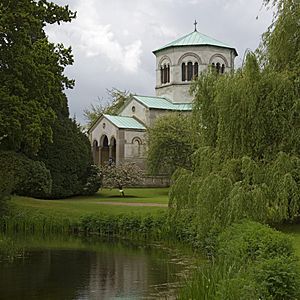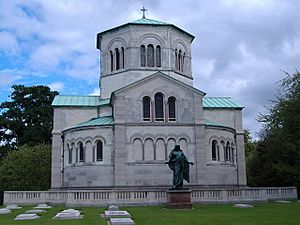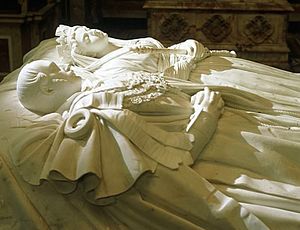Royal Mausoleum, Frogmore facts for kids
Quick facts for kids The Royal Mausoleum |
|
|---|---|

The Royal Mausoleum in 2006
|
|
| Location | Frogmore, Home Park, Windsor, Berkshire, England |
| Built | 1862 to 1871 |
| Architects | Ludwig Gruner A. J. Humbert |
| Architectural style(s) | Neoclassical |
| Governing body | Crown Estate |
|
Listed Building – Grade I
|
|
| Official name: Royal Mausoleum | |
| Designated | 2 October 1975 |
| Reference no. | 1117780 |
| Lua error in Module:Location_map at line 420: attempt to index field 'wikibase' (a nil value). | |
The Royal Mausoleum is a special building where Queen Victoria and her husband, Albert, Prince Consort, are buried. A mausoleum is like a grand tomb or a building that holds the remains of people. This important place is located on the Frogmore estate. Frogmore is part of the Home Park in Windsor, England.
The building was given a special protection status in October 1975. This means it is a very important historic building. It was built between 1862 and 1871. Prince Albert passed away in 1861. He was buried in the mausoleum in 1871 after it was finished. Queen Victoria was buried there on February 4, 1901. This happened after she passed away in late January of that year.
Work on the mausoleum started in March 1862. The main dome was ready by October of that year. The building was officially blessed in December 1862. However, all the beautiful decorations inside were not finished until August 1871.
Contents
Building a Royal Resting Place
Queen Victoria and Prince Albert had planned for a long time to have a special burial place just for them. They did not want to be buried in the usual royal spots. These traditional places included Westminster Abbey or St George's Chapel, Windsor.
In 1861, a mausoleum was being built at Frogmore for the Queen's mother. Then, Prince Albert died in December of that year. Queen Victoria chose the spot for Albert's mausoleum very quickly. She picked the site on December 18, 1861. This was just four days after her husband's death.
Plans for the mausoleum were drawn up by two architects. Their names were Ludwig Gruner and A. J. Humbert. They had also designed the mausoleum for the Queen's mother. Queen Victoria approved the final plans on January 27, 1862. Digging work for the mausoleum began on that same day.
Laying the Foundation Stone
Queen Victoria herself laid the foundation stone. This happened on March 15, 1862. She had wanted to lay the stone on the first anniversary of her mother's death. But that day was a Sunday, so she did it the day before. Many of her children were with her. Many royal staff members also attended the special ceremony.
The total cost to build and decorate the mausoleum was about £200,000. This money came entirely from Queen Victoria and her son, Edward, Prince of Wales. It was paid from their own private money. Some experts say it is the "finest piece of Victorian funerary architecture in Britain." This means it is a top example of a burial building from that time.
Other Monuments Inside
Only Queen Victoria and Prince Albert are buried in the mausoleum. But it also has monuments to other family members. One is for Princess Alice. She was Victoria's second daughter. Princess Alice died in 1878 from a serious illness called diphtheria. Her youngest daughter, May, also died from diphtheria that same year.
In the middle of the mausoleum, there is a monument to Edward, Duke of Kent. He was Queen Victoria's father. He died in 1820 and is buried in St George's Chapel, Windsor.
One special sculpture inside shows Queen Victoria and Prince Albert. They are dressed in old Saxon clothes. This sculpture was made by William Theed after Prince Albert died. It was first shown in 1867 at Windsor Castle. Later, in 1938, it was moved to the Royal Mausoleum. Queen Victoria wrote in her diary that her eldest child, Victoria, Princess Royal, gave her the idea for it.
How the Mausoleum Looks

The mausoleum was built by architect A. J. Humbert. He used designs from Professor Ludwig Gruner. The building is shaped like a Greek cross. This means it has four arms of equal length. It is 70 feet wide and 70 feet tall in the center. The style of the building is called Romanesque. This is an old European style of building.
The mausoleum is made from Portland stone and granite. The roof is covered with copper from Australia.
A Special Message
Above the main door, there is a message written in Latin. It is made of bronze. Here is what it means in English:
Prince Albert who was mortal
the mourning Widow Queen Victoria willed to be buried in this Tomb, the Year of our Lord 1862
Farewell, thou most desired! here at the last I shall rest with thee
I shall rise up with thee in Christ
Inside the Mausoleum
The inside of the mausoleum is very richly decorated. It looks like the High Renaissance style. This style was popular during the time of the famous artist Raphael. Prince Albert thought Raphael was "the greatest artist of all time." Ludwig Gruner was in charge of all the interior decorations.
The walls inside are covered with beautiful red marble from Portugal. This was a gift from King Luis I of Portugal. He was a cousin to both Victoria and Albert. Other types of marble from around the world are also used. The lower part of the walls has a border of marble from Siena, Italy.
There are three chapels inside the mausoleum. Each chapel has special paintings. The South chapel shows the birth of Jesus. The North chapel shows the crucifixion of Jesus. The West chapel shows Jesus's resurrection. An altar is placed in the North chapel.
Paintings of the four evangelists (writers of the Gospels) decorate the curved parts of the central octagon. Statues of the four evangelists also stand in special spaces. Many artists helped with the decorations. These included German painters Julius Frank and Karl Pfänder. Italian artist Nicola Consoni and German sculptors Heinrich Baumer, Hermann Hultzsch, Gustav Kunz, and Friedrich Rentsch also worked on it. Queen Victoria's eldest daughter, Victoria, Princess Royal, painted the entrance area.
The most important part of the mausoleum is the large stone coffin, called a sarcophagus. It holds the remains of Victoria and Albert. On top of the sarcophagus are marble statues of the couple. These statues show them lying down. They were made by the Italian sculptor Carlo Marochetti. The statue of Albert was the last work Marochetti finished before he died. Albert is shown in his Field Marshal uniform. He is also wearing his Order of the Garter medal. The statue of Victoria was made at the same time. It was kept safe until she passed away.
The sarcophagus itself is made from a huge block of granite. This granite came from a quarry in Scotland. The block was very big, weighing over 33 tons. After being shaped into the sarcophagus, it still weighed 18 tons! The lid alone weighed about 4.5 to 5 tons. The granite is described as dark grey or blue.
The sarcophagus sits on a block of black Belgian marble. This marble was a gift from the King of Belgium. Bronze angels kneel in prayer at each corner of the sarcophagus. These angels were sculpted by Marochetti. They were made in a foundry in Paris. The angels were moved away for Queen Victoria's burial ceremony.
The windows of the mausoleum originally had patterned glass. They also showed the family crests of the Saxe-Coburg family. Each window had an angel playing a musical instrument. The stained glass was updated in the early 1900s. This was done under the direction of Edward VII. The dome was also repainted at that time.
Restoration Work
The Royal Mausoleum has been closed to visitors since 2007. It was found that the building was not safe. The land around it was often wet and marshy. This caused the lower parts of the building to break down. In 2011, it was thought that repairs might take another ten years.
In February 2018, the Royal Household announced that repair work was starting. They expected it to be finished by 2023. The work began in June 2018. The main goals were to create a dry area around the building. They also planned to replace the roof. These changes will protect the mausoleum from water damage.
The Mausoleum in Art
In 1869, an artist named Henry William Brewer was asked by Queen Victoria to paint the Mausoleum. The Queen was very interested in watching him work. She even appears in some of these very personal paintings. These artworks are now kept by the Royal Collection Trust.
See also
- William Theed#Double portrait, Queen Victoria and Prince Albert


